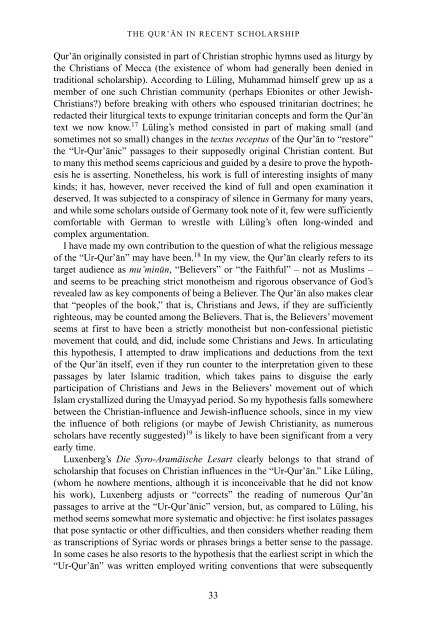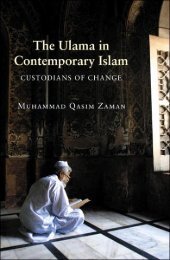The Qur'an in its historical context (pdf - Islam and Christian-Muslim ...
The Qur'an in its historical context (pdf - Islam and Christian-Muslim ...
The Qur'an in its historical context (pdf - Islam and Christian-Muslim ...
You also want an ePaper? Increase the reach of your titles
YUMPU automatically turns print PDFs into web optimized ePapers that Google loves.
THE QUR’AN IN RECENT SCHOLARSHIP<br />
Qur’an orig<strong>in</strong>ally consisted <strong>in</strong> part of <strong>Christian</strong> strophic hymns used as liturgy by<br />
the <strong>Christian</strong>s of Mecca (the existence of whom had generally been denied <strong>in</strong><br />
traditional scholarship). Accord<strong>in</strong>g to Lül<strong>in</strong>g, Muhammad himself grew up as a<br />
member of one such <strong>Christian</strong> community (perhaps Ebionites or other Jewish-<br />
<strong>Christian</strong>s?) before break<strong>in</strong>g with others who espoused tr<strong>in</strong>itarian doctr<strong>in</strong>es; he<br />
redacted their liturgical texts to expunge tr<strong>in</strong>itarian concepts <strong>and</strong> form the Qur’an<br />
text we now know. 17 Lül<strong>in</strong>g’s method consisted <strong>in</strong> part of mak<strong>in</strong>g small (<strong>and</strong><br />
sometimes not so small) changes <strong>in</strong> the textus receptus of the Qur’an to “restore”<br />
the “Ur-Qur’anic” passages to their supposedly orig<strong>in</strong>al <strong>Christian</strong> content. But<br />
to many this method seems capricious <strong>and</strong> guided by a desire to prove the hypothesis<br />
he is assert<strong>in</strong>g. Nonetheless, his work is full of <strong>in</strong>terest<strong>in</strong>g <strong>in</strong>sights of many<br />
k<strong>in</strong>ds; it has, however, never received the k<strong>in</strong>d of full <strong>and</strong> open exam<strong>in</strong>ation it<br />
deserved. It was subjected to a conspiracy of silence <strong>in</strong> Germany for many years,<br />
<strong>and</strong> while some scholars outside of Germany took note of it, few were sufficiently<br />
comfortable with German to wrestle with Lül<strong>in</strong>g’s often long-w<strong>in</strong>ded <strong>and</strong><br />
complex argumentation.<br />
I have made my own contribution to the question of what the religious message<br />
of the “Ur-Qur’an” may have been. 18 In my view, the Qur’an clearly refers to <strong>its</strong><br />
target audience as mu’m<strong>in</strong>un, “Believers” or “the Faithful” – not as <strong>Muslim</strong>s –<br />
<strong>and</strong> seems to be preach<strong>in</strong>g strict monotheism <strong>and</strong> rigorous observance of God’s<br />
revealed law as key components of be<strong>in</strong>g a Believer. <strong>The</strong> Qur’an also makes clear<br />
that “peoples of the book,” that is, <strong>Christian</strong>s <strong>and</strong> Jews, if they are sufficiently<br />
righteous, may be counted among the Believers. That is, the Believers’ movement<br />
seems at first to have been a strictly monotheist but non-confessional pietistic<br />
movement that could, <strong>and</strong> did, <strong>in</strong>clude some <strong>Christian</strong>s <strong>and</strong> Jews. In articulat<strong>in</strong>g<br />
this hypothesis, I attempted to draw implications <strong>and</strong> deductions from the text<br />
of the Qur’an <strong>its</strong>elf, even if they run counter to the <strong>in</strong>terpretation given to these<br />
passages by later <strong>Islam</strong>ic tradition, which takes pa<strong>in</strong>s to disguise the early<br />
participation of <strong>Christian</strong>s <strong>and</strong> Jews <strong>in</strong> the Believers’ movement out of which<br />
<strong>Islam</strong> crystallized dur<strong>in</strong>g the Umayyad period. So my hypothesis falls somewhere<br />
between the <strong>Christian</strong>-<strong>in</strong>fluence <strong>and</strong> Jewish-<strong>in</strong>fluence schools, s<strong>in</strong>ce <strong>in</strong> my view<br />
the <strong>in</strong>fluence of both religions (or maybe of Jewish <strong>Christian</strong>ity, as numerous<br />
scholars have recently suggested) 19 is likely to have been significant from a very<br />
early time.<br />
Luxenberg’s Die Syro-Aramäische Lesart clearly belongs to that str<strong>and</strong> of<br />
scholarship that focuses on <strong>Christian</strong> <strong>in</strong>fluences <strong>in</strong> the “Ur-Qur’an.” Like Lül<strong>in</strong>g,<br />
(whom he nowhere mentions, although it is <strong>in</strong>conceivable that he did not know<br />
his work), Luxenberg adjusts or “corrects” the read<strong>in</strong>g of numerous Qur’an<br />
passages to arrive at the “Ur-Qur’anic” version, but, as compared to Lül<strong>in</strong>g, his<br />
method seems somewhat more systematic <strong>and</strong> objective: he first isolates passages<br />
that pose syntactic or other difficulties, <strong>and</strong> then considers whether read<strong>in</strong>g them<br />
as transcriptions of Syriac words or phrases br<strong>in</strong>gs a better sense to the passage.<br />
In some cases he also resorts to the hypothesis that the earliest script <strong>in</strong> which the<br />
“Ur-Qur’an” was written employed writ<strong>in</strong>g conventions that were subsequently<br />
33



